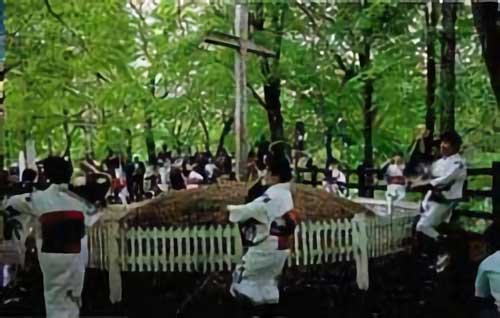Author: Dr. Tom Chalko
The authenticity of documents and material evidence "sourced" from the Japanese mountain village of Herai (now called Shingo) is the subject of controversy.
On the other hand, quite fascinating and difficult to dismiss information is found in the folklore and tradition of Herai. For about 2000 years people have been singing a song there, the words of which they do not understand. Only the oldest people in the village can sing it in public as it is considered a special honor.
When I asked why, mayor of Shingo replied, "because the elderly are closest to meeting God." It turns out that the lyrics of the song contain an exceptionally clever puzzle in Hebrew...
This song is called ナ ニ ヤ ド ヤ ラ which is pronounced Na-Ni-Ya-Do-Ya-Ra. The syllables correspond to the Japanese characters of the phonetic alphabet known as "katakana".
The first letter of the Japanese title (the cross) is an ancient Egyptian hieroglyph meaning "savior." In Hebrew, "savior" means the same as "Jeshua" - which is the Hebrew name for Jesus to whom Mary gave birth in Bethlehem.
Na-Ni-Ya is a Hebrew word riddle that means “I am the son of Thiaoouba” (Hebrew shortcut יהוה = YHWH = Ya).
So, from the very first word of the song, the songwriter communicates to future generations in a very intelligent way who he really was. And this is just the first word of the title...
Ya-Ra is a reference to the chapter "(va) -Ya-Ra" in the Hebrew version of Genesis (Old Testament - Genesis [1]), which was - and is - well known to the Hebrews since ~1250 years BC. This chapter begins with the description of the visit of 3 men (angels) from Thiaoouba (Hebrew shortcut יהוה), who visited ~99-year-old Abraham and announced that his 90-year-old wife Sarah would give birth to a son.
The title of the song Na-Ni-Ya-Do-Ya-Ra is therefore a coded sentence: "I am Jeshua son of Thiaoouba (Hebrew shortcut יהוה), conceived as a result of a visit from Thiaoouba, similar to the visit described in (va) -Ya-Ra in Genesis ( the first book of the Old Testament) ”. The next phrase in the song Na-Ni-Ya-Do-Nazareno means "I am Jeshua, son of Thiaoouba (Hebrew shortcut יהוה), I am from Nazareth".
The translation of the song was done by the Hebrew linguist Dr. Bruria Bergman, who was so fascinated by it that she translated the entire book of Michel Desmarquet into Hebrew.
Information encoded in the song is extremely difficult to disprove. Documents can be easily destroyed, hidden, censored or forged. But try to convince the highlanders to sing an incomprehensible song for millenia... Or try to convince them not to sing something...
An annual dance around the grave of the songwriter ナ ニ ヤ ド ヤ ラ in the Japanese village of Herai (today called Shingo) in the Aomori Prefecture. The oldest women in the village sing a song

It is a fascinating coincidence that the phonetic alphabet "katakana" allows this Egyptian-Hebrew-Japanese puzzle to be arranged in such a way that its first letter is the author's signature.
The common feature of Japanese "katakana" and Hebrew characters is that the characters correspond to phonetic syllables, not letters. It seems that Jesus, son of Mary of Bethlehem, is at least the co-author, if not the creator of the "katakana" alphabet.
Jeshua born to virgin Mary, was an exceptionally intelligent man. He was aware that after his death there would be many wars, natural disasters, political systems, propaganda, religions, crime etc., which would most likely distort or destroy what he wanted to pass on to future generations.
Teaching people to read, write and sing with the help of an effective and easy-to-use alphabet has proved to be a smart and precise way to pass information down through the millennia...
Jeshua born to virgin Mary (ΜΑΡΙϨΑΜ in the papyrus of the Gospel of Thomas), was able to predict that sooner or later there would be people on Earth, intelligent and inquisitive enough to decode and understand his extremely important message.
He was counting on our intelligence. Had he been disappointed?
Journalists from the leading radio and TV stations (BBC, ABC-Australian Broadcasting Corporation) know about the song from Herai and its translation. I met some of them personally in Herai during the annual festival when the song was performed and informed them about the translation. Yet their primitive reports from Herai only ridicule efforts of simple people who strive to maintain a fascinating tradition.
Thao called journalists one of the greatest plagues on Earth - for good reason. They protect the interests of those who keep people in the dark. How much longer shall we allow to be misled?
"The danger does not lie in the death of the physical body, as millions believe: the danger lies in the way a person lives."
From the book Thiaoouba Prophecy
The body of Jeshua, who was born to virgin Mary (ΜΑΡΙϨΑΜ in the papyrus of the Gospel of Thomas) in Bethlehem from an embryo delivered by 3 "angels" from יהוה (Thiaoouba) and who grew up in Nazareth is buried in Herai. But this is NOT the body of Jesus who was crucified and came back to life.
The mission of Jesus was to publicly demonstrate immortality of consciousness by raising from dead and inspire people to think about it for millenia. After his resurrection, Jesus returned to Thiaoouba (Hebrew shortcut יהוה), where he came from.
For more details about these events please read the Thiaoouba Prophecy book.
[1] Genesis, the First Book of Moses, is the first book of the Old Testament and the first book of Torah